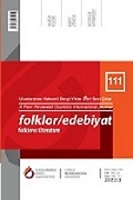Helesa/Heyamola Geleneğindeki Senkretik Unsurlar
Syncretistic Elements in the Helesa/Heyamola Tradition
Author(s): Murat KarasalihoğluSubject(s): Cultural history, Cultural Anthropology / Ethnology, Culture and social structure , Sociology of Culture, Sociology of Religion
Published by: Uluslararası Kıbrıs Üniversitesi
Keywords: Syncretism; Helesa/Heyamola; Abaş Baba; Saint Phocas; Zeus Poarinos;
Summary/Abstract: In this study, within the conceptual framework and context of syncretism, the existence of different belief systems from the historic Helesa/Heyamola tradition, especially seen in the Black Sea Region, was determined and the traditional transformation and transfer points were revealed. Although the origin of the Helesa/Heyamola tradition is seen in maritime occupations, it usually consists of a folk song and a game sung in the form of a chansonette or mani. Despite the tradition having local variations, it is also accompanied by has ritual practices in the form of a tip/charity show, which is performed by using vehicles such as boats and pans during the month of Ramadan. Western Black Sea variants of the tradition are mostly related to maritime and are used in wedding ceremonies in the Eastern Black Sea Region. In this study, variants of the Helesa/Heyamola tradition, especially those related to maritime, were compared with some elements in the Cult of Saint Phokas, which emerged in the Black Sea Region during Late Antiquity and was known to be the protector of sailors. In addition to the concept of chain syncretism, ancient cults of Saint Phokas and the miraculous identity of the saint Abaş Baba, who is known to primarily be the patron of sailors, a gardener and a healer, were also examined. This way, with the help of archaeological data, starting from antiquity, the folkloric reflections of the religious transformation of maritime ritual practices during the acculturation process in the region were followed. Literary works, combined with recent compilations, were examined to show that the syncretic process in the region was a continuation from other districts and that the tradition was still kept alive being rooted in the belief of the Islamic Saint from İnebolu, which is the location of ancient and medieval cults.
Journal: Folklor/Edebiyat
- Issue Year: 28/2022
- Issue No: 111
- Page Range: 697-720
- Page Count: 24
- Language: Turkish

